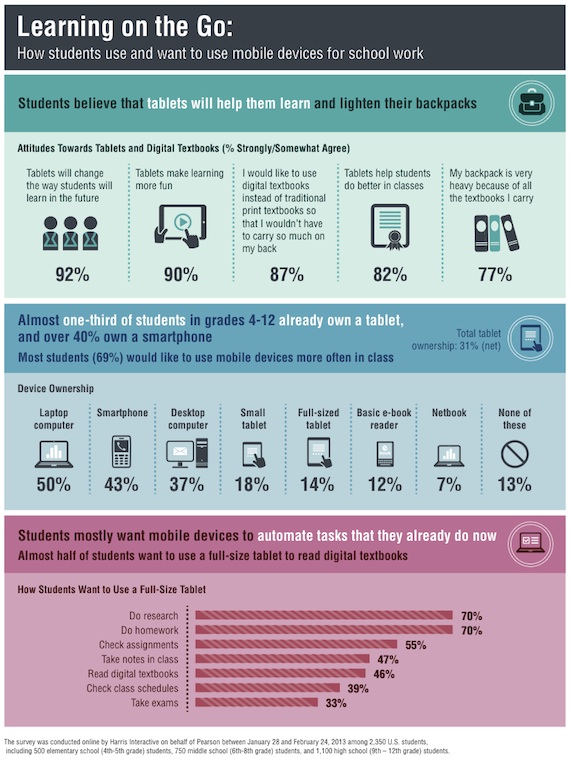Most elementary and secondary students are using mobile devices in their studies, either in the classroom or at home. And, according to a new study, the majority would like to be able to use them more in class.
Which Devices Are Used
The study, conducted by Harris Interactive for educational publisher Pearson, polled more than 2,300 American students in grades 4 through 12 (aged 8 to 18) about their use of digital technologies for educational purposes. It found that only 1 percent of respondents used no digital technologies whatsoever in their studies. Most indicated they use laptops (71 percent) and/or desktops (66 percent). But significant chunks of the student population are also using less traditional computing devices. Half, according to the survey, use smart phones in their education, either in class or at home (or elsewhere). Only 21 percent are using "full-size" tablets (such as the iPad or Google Nexus 10), while slightly more (23 percent) are using small tablets, such as the iPad mini or Google Nexus 7. Basic e-readers (16 percent) and netbooks (10 percent) were the least-used devices among the respondents to the survey.
That usage varies fairly widely by grade level.
In elementary grades, slightly more respondents indicated they use desktops than those who use laptops (68 percent versus 64 percent). But almost a third of the total (32 percent) said they use small tablets versus 21 percent using larger tablets. Thirty-five percent use smart phones for educational purposes. Sixteen percent use basic e-book readers. Netbooks, at 5 percent, are nearly non-existent in elementary grades.
In middle school, the numbers skew slightly more toward smart phones and laptops:
- 70 percent of middle school students use laptops for learning;
- 66 percent use desktops;
- 47 percent use smart phones;
- 25 percent use small tablets;
- 23 percent use larger tablets;
- 17 percent use basic e-book readers; and
- 12 percent still use netbooks.
In high school, penetration of laptops and smart phones jumps considerably, with smart phones edging to within five percentage points of desktops.
- 75 percent of high school students use laptops for educational purposes;
- 65 percent use desktops;
- 60 percent use smart phones;
- 19 percent use full-size tablets;
- 17 percent use small tablets;
- 16 percent use basic e-book readers; and
- 10 percent use netbooks.

Source: Pearson Student Mobile Device Survey 2013, published April 2013. Click for larger images. |
Ownership of these devices is another story. Half of all students own a laptop, while only 37 percent own a desktop. A fairly large 43 percent own their smart phones. (This implies that some of the students who use smart phones for education do not own those devices themselves.) After smart phones, the ownership numbers drop off dramatically: 18 percent own small tablets; 14 percent own full-size tablets; 12 percent own basic e-book readers; and 7 percent own netbooks. A fairly significant 13 percent of students indicated they do not own any of these devices.
